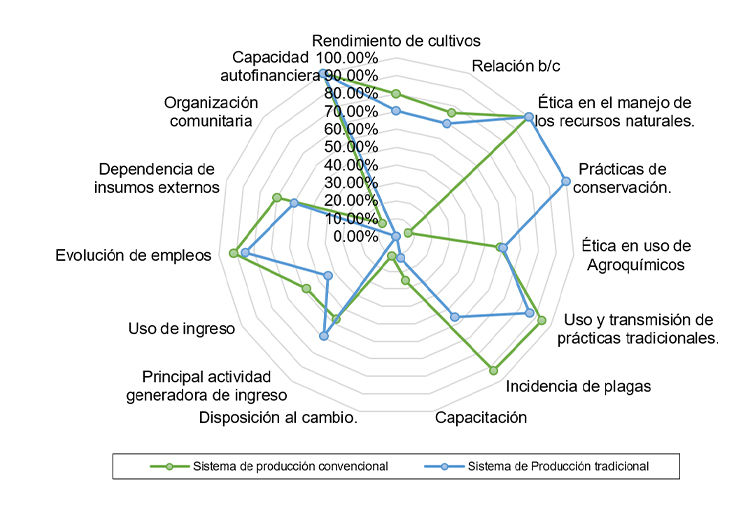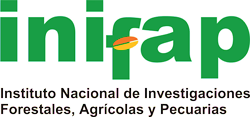Sustainability in prickly pear production in San Pablo Xúchil, Axapusco
DOI:
https://doi.org/10.29312/remexca.v16i6.3782Keywords:
Community, MESMIS, Opuntia albicarpa, sustainable developmentAbstract
The research aims to analyze the traditional and conventional production systems of prickly pear (Opuntia albicarpa) to identify their current sustainability, as well as the social, environmental, and economic relevance that this crop represents for the community. In the eastern region of the state of Mexico, several municipalities stand out for their deep-rooted tradition in the production of prickly pear. In the locality of San Pablo Xúchil, this activity has taken on a central relevance, not only economically, but also culturally. Nonetheless, production has been questioned in terms of its sustainability due to the adoption of practices that are harmful to the environment: monoculture and intensive use of agrochemicals. A questionnaire was applied to 44 prickly pear producers with the framework for the evaluation of natural resource management systems, incorporating sustainability indicators. Fifteen indicators were analyzed with the following dimensions: environmental, economic, and social. The results obtained show that both systems need to increase their sustainability, as a result of weak organization, low training, and high use of agrochemicals.
Downloads
References
Amato, N. C. 2019. Revisión bibliográfica sobre sustentabilidad y ética organizacional: Actores relevantes. Ciencias Administrativas. 13:55-66.
Berber, S. R.; Torcuato-Calderón, C.; Almaguer-Vargas, G.; Colinas-León, M. T. y Khali Gardezi, A. 2012. El sistema productivo del nopal tunero (Opuntia albicarpa y O. megacantha) en Axapusco, Estado de México. Problemática y alternativas. Revista Chapingo. Serie Horticultura. 18(1):81-93.
Bifani, C. P. 1999. Medio ambiente y desarrollo sostenible. 4a Ed. Instituto de Estudios Políticos para América Latina y África. Madrid, España. 121-123 pp.
Callejas, J. N.; Matus, G. J.; García, S. A.; Martínez, D. A. and Salas, G. M. 2009. Situación actual y perspectivas de mercado para la tuna, el nopalito y derivados en el Estado de México. Agrociencia. 43(1):73-82.
Domínguez-García, I. A.; Granados-Sánchez, M. R.; Sagarnaga-Villegas, L. M.; Salas-González, J. M. y Aguilar-Ávila, J. 2017. Viabilidad económica y financiera de nopal tuna (Opuntia ficus-indica) en Nopaltepec, Estado de México. Revista Mexicana de Ciencias Agrícolas. 8(6):1371-1328.
Foladori, G. 1999. Sustentabilidad ambiental y contradicciones sociales. Ambiente & Sociedades. 5:19-34.
Francis, C. A.; Liebelin, G.; Gliessman, S. R.; Breland, T. A.; Creamer, N.; Harwood, R.; Salomonsson, L.; Helenius, J.; Rickerl, D.; Salvador, R.; Widenhoeft, M.; Simmons, S.; Allen, P.; Altieri, A. M.; Flora, C. and Poincelot, R. 2003. Agroecology: the ecology of food systems. Journal of Sustainable Agriculture. 22(3):99-118.
Gallegos, V. C.; Gallegos, M. S. y Mondragón, C. J. 2013. Los sistemas de producción comercial de tuna en México y su aplicación en el Altiplano. In: Producción sustentable de la tuna en San Luis Potosí. Gallegos, V. C.; Gallegos, M. S. y Mondragón, C. J. (eds.). Colegio de Postgraduados-Fundación Produce San Luis Potosí. San Luis Potosí, México. 37-48 pp.
Gliessman, S. R. 2002. Agroecología: Procesos ecológicos en agricultura sostenible. Centro Agronómico Tropical de Investigación y Enseñanza (CATIE). Turrialba, Costa Rica. 359 p.
H. Ayuntamiento de Axapusco. 2022. Plan de Desarrollo Municipal de Axapusco 2022-2024 Gubernamental.
Hernández-Bonilla, B. E.; Ruiz Reynoso, A. M.; Ramírez Cortés, V.; Sandoval Trujillo, S. J. y Dávila Hernández, M. 2020. Análisis económico de productores y comercializadores de nopal en el Valle de Teotihuacán. Revista Iberoamericana de Contaduría, Economía y Administración. 9(17):72-108.
Hernández, S. R. and Mendoza, T. C. 2018. Metodología de la Investigación: las rutas cuantitativa, cualitativa y mixta 1a Ed. Mcgraw-Hill, interamericana editores, SA de CV. Ciudad de México, México. 3-19 pp.
Jolalpa, J. L.; Aguilar-Zamora, A.; Ortíz-Barreto, O. y García-López, L. 2011. Producción y comercialización de tuna en fresco bajo diferentes modalidades en Hidalgo, México. Revista Mexicana de Agronegocios. 28:605-614.
Masera, C. O.; Astier, C. M. y López-Ridaura, S. 1999. Sustentabilidad y manejo de recursos naturales el manejo de evaluación MESMIS. Mundi-Prensa. México, SA de CV. 109 p.
Quecedo, L. R. y Castaño, G. C. 2002. Introducción a la metodología de investigación cualitativa. Revista de Psicodidáctica. 14:5-39.
Ramírez-Abarca, O.; Figueroa Hernandez, E. y Espinosa Torres, L. E. 2015. Análisis de rentabilidad de la tuna en los municipios de Nopaltepec y Axapusco, Estado de México. Revista Mexicana de Agronegocios. 36:1199-1210.
Rzedowski, R. J. 2006. Vegetación de México 1a Ed. Comisión Nacional para el Conocimiento y Uso de la Biodiversidad (CONABIO). México. 12-19 pp.
Santos, P.J.; Muñoz, A. A.; Juez, M.P.; Cortiñas, V.P. 2003. Diseño de encuestas para el estudio de mercado. Técnicas de muestreo y análisis multivariante. Centro de Estudios Ramón Areces, SA. Madrid, España. 728 p.
Secretaría del Campo. 2023. Información estadística agropecuaria por municipio: Axapusco. Secretaría del Campo, con base en el Servicio de Información Agroalimentaria y Pesquera (SIAP). Cierre Agrícola. Ciudad de México, México. https://secampo.edomex.gob.mx/estadisticas-agropecuario.
Vela, R. E. 2019. Cultivos Mesoamericanos: las especies que México dio al mundo. Arqueología Mexicana. (84):61-63.

Published
How to Cite
Issue
Section
License
Copyright (c) 2025 Revista Mexicana de Ciencias Agrícolas

This work is licensed under a Creative Commons Attribution-NonCommercial 4.0 International License.
The authors who publish in Revista Mexicana de Ciencias Agrícolas accept the following conditions:
In accordance with copyright laws, Revista Mexicana de Ciencias Agrícolas recognizes and respects the authors’ moral right and ownership of property rights which will be transferred to the journal for dissemination in open access. Invariably, all the authors have to sign a letter of transfer of property rights and of originality of the article to Instituto Nacional de Investigaciones Forestales, Agrícolas y Pecuarias (INIFAP) [National Institute of Forestry, Agricultural and Livestock Research]. The author(s) must pay a fee for the reception of articles before proceeding to editorial review.
All the texts published by Revista Mexicana de Ciencias Agrícolas —with no exception— are distributed under a Creative Commons License Attribution-NonCommercial 4.0 International (CC BY-NC 4.0), which allows third parties to use the publication as long as the work’s authorship and its first publication in this journal are mentioned.
The author(s) can enter into independent and additional contractual agreements for the nonexclusive distribution of the version of the article published in Revista Mexicana de Ciencias Agrícolas (for example include it into an institutional repository or publish it in a book) as long as it is clearly and explicitly indicated that the work was published for the first time in Revista Mexicana de Ciencias Agrícolas.
For all the above, the authors shall send the Letter-transfer of Property Rights for the first publication duly filled in and signed by the author(s). This form must be sent as a PDF file to: revista_atm@yahoo.com.mx; cienciasagricola@inifap.gob.mx; remexca2017@gmail.
This work is licensed under a Creative Commons Attribution-Noncommercial 4.0 International license.


